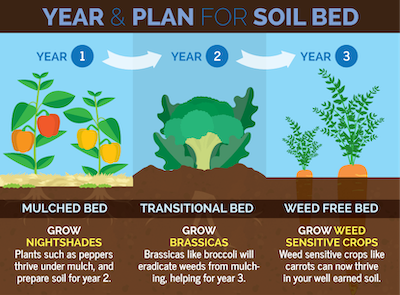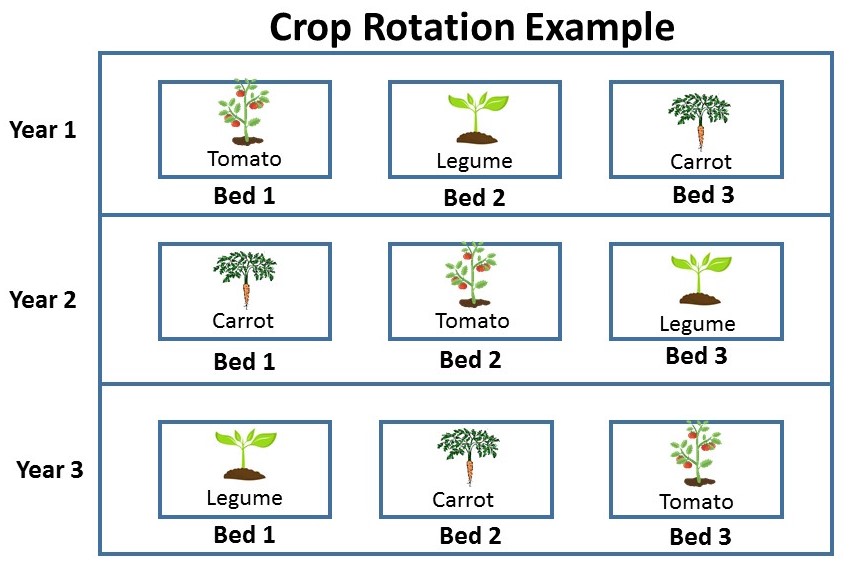Crop Rotation & Other Strategies to Minimize Pests
By Janet Scheren, Fairfax Master Gardener Intern
If you plant it, they will come. And if you plant it year after year, they will move in and take up residence. Thus, gardeners employ multiple strategies to outwit and defeat pests and diseases in their garden beds. Crop rotation heads the list of effective strategies gardeners have employed for centuries. Farmers in Belgium pioneered a four-field rotation in the early 16th century, but the system was popularized in the 18th century by British agriculturist Charles Townshend. It remains an essential strategy to this day.
 The basic fundamental of crop rotation is that plants in the same family attract similar pests and diseases. Thus, by rotating them to a different location every year for several years, these problems don’t have the chance to settle in and take control. Crops from the same plant family also have similar nutritional needs, requirements for soil and light, and are grown at the same time of year. The plot thickens when you consider the number of plant families you want to incorporate in your garden, the nutrient needs of each family, and whether each is a cool or warm season crop. Additionally, many crop rotation plans incorporate a fallow season with a cover crop planted to help rebuild the soil.
The basic fundamental of crop rotation is that plants in the same family attract similar pests and diseases. Thus, by rotating them to a different location every year for several years, these problems don’t have the chance to settle in and take control. Crops from the same plant family also have similar nutritional needs, requirements for soil and light, and are grown at the same time of year. The plot thickens when you consider the number of plant families you want to incorporate in your garden, the nutrient needs of each family, and whether each is a cool or warm season crop. Additionally, many crop rotation plans incorporate a fallow season with a cover crop planted to help rebuild the soil.
Major Crop Families
Start designing your crop rotation strategy by identifying the plant families you want to include:
Bean Family (Fabaceae)
Legumes — beans and peas — are easy to plant. Other than peas, which are cool season crops, this family enjoys warmer temperatures. All work with nitrogen-fixing bacteria and don’t require as many added nutrients. They can be planted before or after any other crop family, except onions. All onion family members kill the beneficial bacteria on bean roots and keep them from adding nitrogen to the soil.
Beet Family (Goosefoot Family, Chenopodiaceae)
Beets, spinach and Swiss chard are cool season crops, although Swiss chard can often survive summer if given a respite from the heat of the day.
Cabbage Family (Brassicaceae)
This large family includes arugula, broccoli, Brussel sprouts, bok choy, cauliflower, cabbage, kale, radishes and mustard. These plants can stand up against moderate frosts and cold temperatures. Except for radishes, mustard and kale, brassicas are larger plants and can take 2 to 3 square feet of space per plant, so factor that into your garden bed size.
Carrot Family (Apiaceae)
Carrots, fennel, cilantro, dill, parsley and parsnips don’t take up much space in the garden and are best started from seed.
Cucumber Family (Cucurbitaceae)
Cucumbers, squash, pumpkins and melons are all warm weather plants that are best directly sown in the ground. They all require a decent amount of water and are prone to disease and pests, including powdery mildew and squash vine borer. All can be grown on a trellis. If left to spread on the ground, pumpkins and winter squash can easily spread to fill a 10 by 10 foot plot. These may need to be located out of your rotation beds. Nonetheless, they should not be planted in the same place each year as they are susceptible to both the fungi and pests afflicting this group.
Grass Family (Graminae)
Oats, rye, barley and wheat are cool/cold season plants, which can be easily grown in containers as well as in the ground. Corn is the warm season plant in this group and requires a large area in the garden.
Lettuce Family (Composite, Daisy Family, Asteraceae)
Artichokes, chicory, endive and lettuce are often interplanted among those in the cabbage family.
Mint Family (Lamiacaeae)
Lemon balm, oregano, rosemary, mint, lavender, sage and basil all favor sun, heat and well-drained soil without a lot of nutrients added.
Onion/Allium Family (Amaryllidaceae)
Onions, garlic, leeks, chives and shallots are great plants to place in the border of your garden (except near beans) as they can help repel deer and other pests.
Tomato Family (Solanaceae)
Tomatoes, tomatillos, peppers, eggplants and potatoes belong to the Nightshade family. They like warm weather, have deep roots and are heavy feeders. They are susceptible to powdery mildew and soil-borne diseases and pests. All can be grown in containers as well as in the ground.
Planning Your Garden Rotation
A typical rotation plan might include four garden sections of similar size separated by aisles for maintenance. The plots could be a simple as four 4-foot squares or raised beds separated by 2 to 3 foot aisles. In this scenario, Plant Family A starts in Plot 1, then moves through each of the other three plots in successive years. Plant Family B starts in Plot 2 and also rotates sequentially … and so forth with all the plant families and garden sections.
 While the concept of crop rotation is simple, implementation can take some thought and preparation depending on the number of plant families or groupings you want to include in your garden and the size and location of your garden space. Smaller yards and gardens — or ambitious gardeners wishing to incorporate more than four plant families — might not have the space to give each plant family its own bed. However, you can combine more than one plant family in each bed as long as the plants are compatible and the group doesn’t find itself in the same soil for at least two to three years. Selecting plant groupings by the following feeding needs can also be effective:
While the concept of crop rotation is simple, implementation can take some thought and preparation depending on the number of plant families or groupings you want to include in your garden and the size and location of your garden space. Smaller yards and gardens — or ambitious gardeners wishing to incorporate more than four plant families — might not have the space to give each plant family its own bed. However, you can combine more than one plant family in each bed as long as the plants are compatible and the group doesn’t find itself in the same soil for at least two to three years. Selecting plant groupings by the following feeding needs can also be effective:
- Heavy Feeders — artichokes, asparagus, beets, broccoli, Brussels sprouts, cabbage, cauliflower, celery, collard, corn, eggplants, endive, kale, lettuce, parsley, peppers, potatoes, pumpkins, radishes, rhubarb, spinach, squash, strawberries, tomatoes
- Medium Feeders — melons, beans, sweet potatoes
- Light Feeders — carrots, garlic, leeks, mustard greens, onions, parsnips, rutabagas, shallots, sweet potatoes, Swiss chard
- Nitrogen Fixers — alfalfa, beans, clover, peas, peanuts, soybeans
The N, P, K Model for Crop Rotation
This method of crop rotation, explained by Ellen Ecker Ogden, groups beds by the key nutrients needed for similar plants. Nitrogen (N) promotes leafy growth, so this group would be all your leafy greens. Phosphorus (P) is for root growth, thus your root vegetables fall into this category. The next group in the rotation plan is Potash (K), which stimulates fruit production for tomatoes, cucumber, squash, eggplant, peppers, melon and such. This can be followed by legumes, which are your nitrogen fixers, or a fallow patch to help regenerate the soil before starting over with leafy greens. Onions and their cousins are the outliers in this system, and they should not proceed legumes. One solution is to plant them at the border of your garden to help deter pests. They can also immediately follow the legumes.
Building a Healthy Ecosystem
If well-designed and implemented, crop rotation reduces the need for fertilizers and herbicides by building a healthy ecosystem through diversity. It can also improve soil structure and incorporate organic matter. Soil can be amended with compost or well-rotted manure between rotations. Additionally, mulch your soil or plant it with a cover crop. Typical cover crops include winter rye, field peas, ryegrass, crimson clover, Austrian peas, oats and hairy vetch — or a mixture of these seeds.
Interplanting with herbs and other companion plants is a complementary strategy that can also help control pests and disease while expanding the variety of crops in your garden. Many crops benefit from having herbs or flowers planted among them to repel pests, act as natural fungicides or to attract beneficial insects. Build your insect ecosystem by ensuring lots of blossoms in your garden from early spring to late fall. Good choices are zinnias, marigolds and flowering herbs. Snapdragons and daikon radish blooms are great early bloomers for spring pollinators.
In my garden, I planted flowers in an area 3 feet wide, the length of my garden, with vegetable beds on either side. The addition of the flowers not only enhanced the beauty of my garden, it added a plethora of pollinators and a wide range of beneficial insects. None of my tomatoes or squash family members went without pollinators. My garden was aphid free, and I had the amazing experience of finding a tomato hornworm I had missed dying with eggs of parasitic wasps growing on it. The benefits of a healthy ecosystem are real.
Resources
• Beginners’ Guide: Planning A Vegetable Garden, Gil Medeiros, Fairfax Master Gardener
• Home Vegetable Gardening, Virginia Cooperative Extension
• Grow Great Virginia Vegetables, Ira Wallace, 2020, Timber Press
• Vegetable Garden Rotations, prepared by Thurston County, its Cities, and the Washington State
Department of Ecology, 2010
• Plant Rotation in the Garden Based on Plant Families, Penn State Extension, 2007
• Vegetables Love Flowers, by Lisa Mason Ziegler, 2018
• The Complete Kitchen Garden, by Ellen Ecker Ogden, 2011